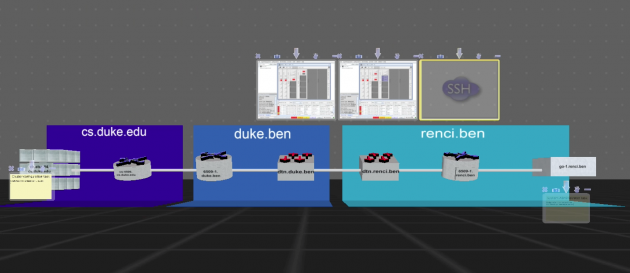
A screen shot of GENI’s Collaborative Interactive Infrastructure (GCii) using Open Cobalt interface
Research teams from across the U.S. convened at Duke University March 16 – 18 for the Seventh GENI Engineering Conference (GEC7), organized by the GENI Project Office (GPO) and hosted by Duke and RENCI. Ilya Baldin, RENCI’s director of network research and infrastructure, and Jeff Chase, a professor of computer science at Duke, co-chaired the conference.
GENI—the acronym for Global Environment for Network Innovations—is a virtual laboratory where the nation’s best networking researchers conduct experiments to understand and transform global networks and how they are used for research, business, entertainment and social interaction. Supported by the National Science Foundation, GENI provides dedicated networks and network resources where researchers can explore the possibilities of future internets.
Research groups building experimental network infrastructure, devices and network “sandboxes” where research can take place undisturbed by the demands of commercial networks attended GEC7 and presented their work at a demonstration showcase March 16 at Duke’s Fitzpatrick Center. Two demonstrations out of 34 featured RENCI and Duke work:
- ORCA/BEN is a RENCI and Duke project to adapt the Open Resource Control Architecture (ORCA), developed by Chase and New Internet Computing Lab at Duke, to RENCI’s Breakable Experimental Network (BEN) a non-production environment for network research. Researchers Chase and Baldine hope to demonstrate that ORCA can be the prototype control framework for GENI.
In the GEC7 demonstration, a dedicated network transported data from environmental sensors in Massachusetts to a virtual computer and analysis tools connected to the BEN node at Duke. The demonstration showed that a dedicated experimental “slice” of a total network resource can be set up on demand to meet the needs of a research group and that those resources can be put back into the experimental network system and made available to other researchers once the experiment is completed. (Watch the video below)
Team members: Ilia Baldine, RENCI; Jeff Chase and David Becker, Duke; Aydan Yumerefendi, former Duke student; Aniban Mandel, Yufeng Xin and Chris Heermann, RENCI.
- GENI’s Collaborative Interactive Infrastructure (GCii) using Open Cobalt allows researchers, engineers, infrastructure providers and system administrators to come together in a virtual environment to manage and monitor both networking and distributed system resources. Developed by Duke University’s Julian Lombardi , assistance vice president in the Office of Information Technology and Open Cobalt principal architect, and RENCI Senior Research Scientist Chris Heermann, the system visually presents the network and its components in a collaborative, real-time virtual space within Open Cobalt, an open source virtual environment that establishes virtual workspaces and a shared interface for interaction.
Using GCii collaborators can share network resource information across administrative domains using common communication tools integrated into Open Cobalt (Web browsers, chat, Voice over IP and spreadsheets etc.) to facilitate GENI experimentation. (Watch the video below)
Team members: Chris Heermann and Steve Chall, RENCI; Julian Lombardi, Duke
In addition, a research team led by Dan Bedard, RENCI’s senior research device engineer, presented a poster on the 10 gigabit per second OpenFlow switch, a high-speed implementation of OpenFlow on the Sixis SX1000-DS reconfigurable computing platform. The OpenFlow open networking standard allows researchers to isolate and route network traffic in individual flows identified by any combination of 10 identifying packet parameters (e.g., MAC / IP addresses, ports, VLAN ID). Implementing this standard on a reconfigurable platform allows researchers to develop new techniques to achieve high performance and to add new features as OpenFlow matures. When completed the switch will be the highest bandwidth reconfigurable OpenFlow switch in the world.
Team members: Dan Bedard, Yufeng Xin, Shu Huang, RENCI; Sixis, Inc.


